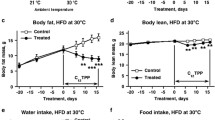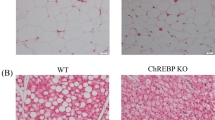Abstract
In this study, we investigate the in vitro effect of zinc addition on guanosine diphosphate (GDP) binding to mitochondria in brown adipocytes of genetically obese (ob/ob) mice. Interscapular brown adipocytes of male mice (obese; lean) at 4 and 12 wk of age were incubated with 0, 50, 100, or 200 μM zinc sulfate. Mitochondria were then isolated and their GDP binding capacities were measured. The GDP-binding capacities of ob/ob mice were lower than lean mice, with or without zinc addition, in both age groups (p<0.05). Zinc addition did not have any significant effect on GDP binding in lean mice. GDP binding decreased with increasing zinc addition in ob/ob mice, and this attenuation was more predominant in 12-wk old ob/ob mice. Moreover, we found that high magnesium addition (5 mM) increased GDP binding in lean mice, but this effect was not significant in ob/ob mice. This study reveals that brown adipose tissue thermogenesis in ob/ob mice could be greatly attenuated by zinc addition, suggesting that zinc may play a regulatory role in obesity.
Similar content being viewed by others
References
M. D. Chen, P. Y. Lin, W. H. Lin, and V. Cheng, Zinc in hair and serum of obese individuals in Taiwan,Am. J. Clin. Nutr. 48, 1307–1309 (1988).
G. Di-Martino, M. G. Matera, B. De-Martino, C. Vacca, S. Di-Martino, and F. Rossi, Relationship between zinc and obesity,J. Med. 24, 177–183 (1993).
N. Begin-Heick, M. Daple-Scott, J. Rowe, and M. M. Heick, Zinc supplementation attenuates insulin secretory activity in pancreatic islets of the ob/ob mouse,Diabetes 34, 179–184 (1985).
M. L. Kennedy and M. L. Failla, Zinc metabolism in genetically obese (ob/ob) mice,J. Nutr. 117, 886–893 (1987).
W. H. Lin, M. D. Chen, and P. Y. Lin, Investigation of the profile of selected trace metals in genetically obese (ob/ob) and lean (+/?) mice,J. Formosan Med. Assoc. 91, s27-s33 (1992).
P. J. Collipp, New development in medical therapy of obesity: thyroid and zinc,Pediatr. Ann. 13, 465–472 (1984).
M. D. Chen, W. H. Lin, and P. Y. Lin, Zinc sulfate and thyroxine treatment on the obese patients,Chin. Med. J. 48, 210–216 (1991).
M. D. Chen, P. Y. Lin, V. Cheng, and W. H. Lin, Zinc supplementation aggravates body fat accumulation in genetically obese mice and dietary-obese mice,Biol. Trace Element Res. 52, 125–132 (1996).
P. Y. Lin, S. J. Liou, M. D. Chen, V. Cheng, P. Alexander, and W. H. Lin, Effects of zinc supplementation on the plasma glucose level and insulin activity in genetically obese (ob/ob) mice,Int. J. Obesity 19 (Suppl. 2), 63 (1995).
N. J. Rothwell and M. J. Stock, Brown adipose tissue: does it play a role in the development of obesity,Diabetes Metab. Rev. 4, 595–601 (1988).
J. Himms-Hagen, Brown adipose tissue thermogenesis: interdisciplinary studies,FASEB J. 4, 2890–2898 (1990).
G. Paolisso and E. Ravussin, Intracellular magnesium and insulin resistance: results in Pima Indians and Caucasians,J. Clin. Endocrinol. Metab. 80, 1382–1385 (1995).
T. W. Balon, J. L. Gu, Y. Tokuyama, A. P. Jasman, and J. Nadler, Magnesium supplementation reduces development of diabetes in a rat model of spontaneous NIDDM,Am. J. Physiol. 269, E745-E752 (1995).
A. G. Swick and R. W. Swick, Changes in GDP binding to brown adipose tissue mitochondria and the uncoupling protein,Am. J. Physiol. 255, E865-E870 (1988).
J. N. Fain, N. Reed, and R. Saperstein, The isolation and metabolism of brown fat cells,J. Biol. Chem. 242, 1887–1894 (1967).
F. Denizot and R. Lang, Rapid colorimetric assay for cell growth and survival: modifications to the tetrazolium dye procedure giving improved sensitivity and reliability,J. Immunol. Methods 89, 271–277 (1986).
B. Cannon and O. Lindberg, Mitochondria from brown adipose tissue: isolation and properties,Methods Enzymol. 55, 65–78 (1979).
M. A. K. Markwell, S. M. Haas, N. E. Tolbert, and L. L. Bieber, Protein determination in membrane and lipoprotein samples: manual and automated procedures,Methods Enzymol. 72, 296–303 (1981).
M. Desautels, G. Zaror-Behrens, and J. Himms-Hagen, Increased purine nucleotide binding, altered polypeptide composition, and thermogenesis in brown adipose tissue of cold-acclimated rats,Can. J. Biochem. 56, 378–383 (1978).
K. H. Falchuk, K. L. Hilt, and B. L. Vallee, Determination of zinc in biological samples by atomic absorption spectrometry,Methods Enzymol. 158, 422–434 (1988).
Statistical Analysis System Institute Inc.,SAS User's Guide: Statistics, SAS Institute, Cary (1985).
M. K. Hambidge, C. E. Casey, and N. F. Krebs, Zinc, inTrace Elements in Human and Animal Nutrition, 5th ed., W. Mertz, ed., Academic, New York, pp. 1–137 (1986).
J. M. Berg and Y. Shi, The galvanization of biology: a growing appreciation for the roles of zinc,Science 271, 1081–1085 (1996).
T. A. Link, and G. von Jagow, Zinc ions inhibit the Qp center of bovine heart mitochondrial bc1 complex by blocking a protonatable group,J. Biol. Chem. 270, 25,001–25,006 (1995).
H. P. Roth, and M. Kirchagessner, Zinc and insulin metabolism,Biol. Trace Element Res. 3, 13–32 (1981).
P. Faure, A. Roussel, C. Coudray, M. J. Richard, S. Halimi, and A. Favier, Zinc and insulin sensitivity,Biol. Trace Element Res. 32, 305–310 (1992).
S. Kobayashi, Y. Gao, R. L. Ong, and C. S. Pittman, Substrate specificity of iodothyronine 5′-deiodinase in rat liver homogenates and its requirements of divalent cations in vitro,Life Sci. 16, 2231–2238 (1986).
R. A. Reinhart, Magnesium metabolism: a review with special reference to the relationship between intracellular content and serum levels,Arch. Intern. Med. 148, 2415–2420 (1988).
Author information
Authors and Affiliations
Rights and permissions
About this article
Cite this article
Chen, MD., Lin, PY., Chen, PS. et al. Zinc attenuation of GDP binding to brown adipocytes mitochondria in genetically obese (ob/ob) mice. Biol Trace Elem Res 57, 139–145 (1997). https://doi.org/10.1007/BF02778197
Received:
Revised:
Accepted:
Issue Date:
DOI: https://doi.org/10.1007/BF02778197




